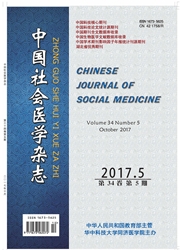

 中文摘要:
中文摘要:
目的:分析第六次人口普查中湖北省人口分年龄、地区、月份的死亡水平差异以及相关影响因素,了解2010年湖北省死亡模式,为制定科学合理的卫生政策提供依据。方法:选取2010年全国人口普查中湖北省相关人口死亡资料,对年龄、性别、地区、时间的死亡差异进行统计分析及相关影响因素分析,发现死亡的分布特点和发展规律,并对湖北省总死亡率进行纵向比较。结果:第六次人口普查中,湖北省人口总粗死亡率为5.39‰,标化死亡率为4.15‰,城镇乡间人口死亡率存在明显差异,标化死亡率从低到高依次为:城市(2.92‰)、镇(3.49‰)、乡(5.24‰)。死亡率最高的月份是2010年10月,最低的是2010年6月。死亡率最高的地区是恩施市,为72.83‰,死亡率最低的是武汉市,为46.11‰。2010年湖北省0岁组人口的期望寿命为74.28岁。另外,婚姻状况以及受教育程度对死亡率的差异影响存在统计学意义。结论:第六次人口普查数据显示,湖北省总人口死亡率呈现下降趋势,预期寿命不断提高,居民健康水平大体呈现良性发展。
 英文摘要:
英文摘要:
Objective To investigate the the mortality patterns by analyzing the death levels of population according to the age, area, month and other factors in Hubei Province in 2010, so as to provide evidences for health policy making. Methods Death data of Hubei Province were retrieved from the Sixth national census in 2010.and then Statistically analyzed the death differences and its related factors based on the different age,gender,area and time for finding the distribution feature and development regularity of death. Moreover, the total death rate of Hubei province was longitudinally compared. Results The crude death rate was 5.39%o, the standardized mortality rate was 4.15%c, there were significant differences in standardized mortality rate in urban population and rural population, the order of the mortality rates from low to high was the city ( 2. 92‰), town( 3.49‰), township ( 5.24‰). The highest mortality of the month was October 2010, the lowest was June 2010.The area with highest mortality rate was Enshi(72.83‰) , while in Wuhan city was 46.11‰.Population life expectancy in 0 age group was 74.28 years old of Hubei Province in 2010.In addition, the marital status, educational levels also influenced the mortality rate.Conclusion The sixth census data showed that the mortality of the total population of Hubei Province has a decline tendency,life expectancy is rising,the health level of residents showes a good development in general.
 同期刊论文项目
同期刊论文项目
 同项目期刊论文
同项目期刊论文
 期刊信息
期刊信息
